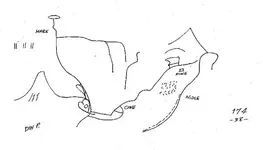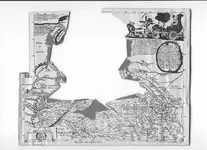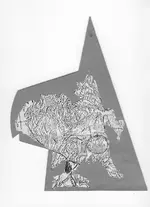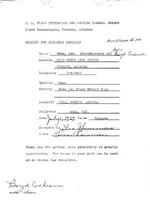Hi All,
Attached is a link that will take you to the Mineral investigation of the Superstition Wilderness and Contiguous Rare II Further Planning Areas, Gila, Maricopa, and Pinal Counties, Arizona
U.S. Bureau of Mines Mineral Land Assessment, MLA 136-82-1982, By Jinks, J.E.
Excerpt from page 6(pdf page);
Lost Dutchman gold mine legend
The portion of the Superstition Mountains situated at the west end of the Superstition Wilderness has long been considered the most likely location of the legendary Lost Dutchman Gold Mine (Blair, 1975).
Weaver's Needle in the NWI/4 sec. 18, T. I N., R. I0 E. is often thought to be one of the key landmarks for finding the lost mine.
Jacob Waltz, the Dutchman of the legend, died in Phoenix in 1891. Since then, treasure hunters in search for the lost mine have dug hundreds of holes in sight of Weaver's Needle.
The sites of many of the pits, gopher holes, shafts, and tunnels were selected on the basis of lost-treasure maps or psychic phenomena. Bureau of Mines personnel sampled and mapped some of the lost treasure diggings during the present survey.
Most workings are in unconsolidated, nonstratified surface material or show no evidence of alteration, mineralization, or other geologic indication of mineral deposition. But despite these odds, people continue to search for the Lost Dutchman Gold Mine and other legendary lost mines and treasures within the Superstition Mountains.
Excerpt from pages 7 & 8 (from pdf)
Mining history and production
According to J. B. Tenney (Wilson and others, 1967), Spanish and Mexican miners in Arizona, prior to the acquisition of the territory by the United States, mined a little silver but no appreciable gold. Tenney comments that, except for some prospecting and mining near Tubac and Tucson prior to the Civil War and some prospecting and mining of rich gold placers in the central part of the state during the Civil War, little prospecting and mining were done in Arizona before the establishment of peace with the Indians about 1872.
The silver deposits of Silver King, Globe, and Superior, east and south of the Superstition study area, were discovered about 1874; presumably, the Superstition study area was prospected at the same time or shortly thereafter.
The Goldfield Mine, about 2 ml west of the study area (pl. I), is reported to have been worked during the early 1890's (Wilson and others1967). At about the same time, initial work at the Palmer Mine. Located inside the proposed western addition to the Superstition Wilderness, was begun. The Palmer Mine has produced gold. The asbestos and iron prospects outside the southeast boundary of the Wilderness have no recorded production.
The adits in upper Rogers Canyon and the workings in upper Whetrock Canyon may have produced silver but there is no official record of such production. During the time of the field investigations, there were no producing mines within the Superstition Wilderness or the proposed additions.
Mining claims and mineral leases
Bureau of Mines personnel searched Federal public land records and county courthouse records for information on mining claims and mineral leases within the Superstition study area in 1973. Public land records of the U.S. Bureau of Land Management at the Arizona State Office in Phoenix showed no patented mining claims and no mineral leases, past or present, within the study area. Notices of location of mining claims and affidavits of annual labor on file at the Pinal County Courthouse in Florence and the Marlcopa County Courthouse in Phoenix indicate continuing low-level mineral activity in the study area. A search of the mining records of Gila County at Globe revealed few notices of location for claims in or adjacent to the study area. Most of the mining claims filed over the years have not been maintained by the filing of affidavits of annual labor or assessment work. Some of the mining claim notices refer to lost mines or lost treasures, and many more notices have names which suggest that the claimant was primarily interested in legendary mines. Scattered older mining claims in and near the southeast corner of the Wilderness were staked on showings of asbestos and iron. Blocks of mining claims held by major mining companies near the Superstition Wilderness include claims connected with the Pinto Valley Mine east of the Wilderness and claims connected with porphyry copper exploration southeast of the Wilderness between Miami and Superior. The boundaries of the blocks of mining claims extend roughly along the west side of Pinto Creek Valley and along Haunted Canyon.
http://www.mines.az.gov/DigitalLibrary/USBM_MLA/USBM_MLA_136-82.pdf
If we look at the area in question realistically we would not find any group of Mexicans (Peraltas, Gonzales) looking/prospecting for gold in known Apache lands until the Apache were crushed. The Apache hated the Mexicans and would take any opportunity to wipe them out, especially when they entered their lands so boldly, without fear. You never poke a stick into the eye of an Apache and get away with it. I have had numerous Apache friends throughout the years and know quite well what can happen once you are standing upon their lands and you are the only white man that can be found for many miles.
The other problem that exists is related to the Superstitions themselves. Ask any normal Catholic raised Hispanic person to accompany you into the Soups for a couple days, no Apache to worry about, we have plenty of food and water, etc. After maybe one day, two at the most they will run from the area filled with fear due to the fact of their superstitious nature. How do you think the Superstition Mountains earned the name? I have access to an excellent Yaqui/Mexican/Catholic raised guide who respects (fears) the Soups and will to this day swear that the infamous Jesuit known as the “Black Robe” is alive and well, and in fact grabbed his foot and tried to pull him out of his tent. He is still literally “frightened to death” even to this day. Sal was raised by his mother and father and was taught the legends of the “Black Robes” and he believes the stories based on the knowledge of his tribe, the Yaqui. You did not cross these warriors either. Sal believes in the Jesuit Mines and treasures, just as I do. The Peralta legends? Not for a minute.
Later,
Ellie Baba










